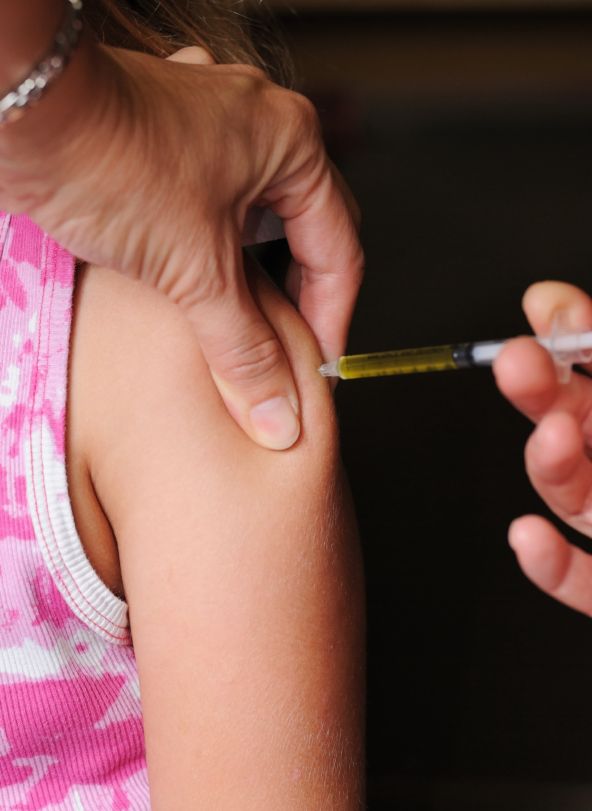Effort Launched to Increase HPV Vaccine Uptake
Sixty-nine National Cancer Institute–designated cancer centers are urging parents, young adults, and healthcare providers to increase HPV vaccination rates, with only an estimate 40% of girls and 21% of boys in the United States receiving the recommended three doses of the HPV vaccine.
vaccine

Sixty-nine National Cancer Institute (NCI)—designated cancer centers are urging parents, young adults, and healthcare providers to increase HPV vaccination rates, with only an estimate 40% of girls and 21% of boys in the United States receiving the recommended three doses of the HPV vaccine.
“The availability of safe and effective vaccines that can prevent six different cancers is an amazing medical achievement. Unfortunately, the current low rates of immunization are threatening the public’s health by leaving many people susceptible to these cancers,” said Linda Niccolai, associate professor of epidemiology of microbial diseases at the Yale School of Public Health. “It is estimated that current low rates of coverage will result in more than 50,000 excess cases of cervical cancer in the future.”
The consensus statement issued by all NCI-designated cancer centers deems the low uptake of the vaccine by both boys and girls as “a serious public health threat” and urges healthcare practitioners to strongly recommend the vaccine.
In an interview on the NCI’s blog, Cancer Currents, Noel Brewer, chair of the National HPV Vaccination Roundtable, suggested that doctors are failing to recommend the vaccine because they are reluctant to discuss sex, and also feel that such discussions would be too time-consuming.
Further, some parents reportedly hesitate to vaccinate their children because they worry that protection from HPV will promote sexual promiscuity. Not so, according to a 2014 study published in the Canadian Medical Association Journal.1 The study followed 260,000 girls for more than 4 years and found no difference in the numbers of pregnancies or sexually transmitted diseases when comparing vaccinated study participants with those who were unvaccinated.
HPV Vaccine Uptake Especially Low Among Boys
A recent study by the CDC published online in the journal Pediatrics revealed that the majority of American boys are not getting the 3-shot HPV vaccine series. The researchers found that boys aren’t getting the vaccine because their doctors aren’t recommending them, and because their parents—not understanding the benefits or safety level of the shots—aren’t asking for them.2 The HPV vaccine, which is FDA-approved and became available in 2006, has been recommended for boys since 2011.
In the study, researchers used data from the 2013 National Immunization Survey-Teen to determine the percentage of boys aged 13 to 17 who had taken an initial HPV vaccine (34.6%), and also the proportion of boys who had completed the series of three (13.9%). The researchers found the uptake was higher among blacks and Hispanic adolescents compared with their white male counterparts.
Approximately 79 million individuals in the United States are currently infected with HPV, and 14 million new infections occur each year, according to the CDC. In addition, the agency estimates that 27,000 men and women will be diagnosed with a HPV-related cancer, equivalent to a new case every 20 minutes.
The unanimously supported consensus statement is directed to parents and young men (up to age 21) and young women (up to age 26), urging them to complete the HPV vaccine series and to talk with their healthcare providers about it.
And for the third audience, healthcare providers, the message is clear:
“We encourage all healthcare providers, to be advocates for cancer prevention by making strong recommendations for HPV vaccination,” the statement urges.
“We can, and must, do better. The current underuse of HPV vaccines is a solvable problem. Working together, medical professionals, public health officials, and the public can make a difference,” Niccolai said.
- Smith LM, Kaufman JS, Strumpf EC, Levesque LE. Effect of human papillomavirus (HPV) vaccination on clinical indicators of sexual behavior among adolescent girls: the Ontario Grade 8 HPV Vaccine Cohort Study. CAMJ. 2015;187(2):E74-E81.
- Lu PJ, Yankey D, Jeyarajah J, et al. HPV vaccination coverage of male adolescents in the United States. Pediatrics. 2015;136(5):839-849.



